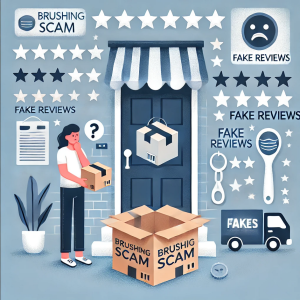A brushing scam is a deceptive practice used by some online sellers to artificially inflate the visibility and perceived popularity of their products. Here’s how it works, explained simply:
The Process
- Fake Purchases: Scammers obtain your name and address (often from a data breach or public source).
- Ship Unsolicited Items: They ship low-cost or lightweight items to you, such as a keychain, face mask, or trinket, without your knowledge or request.
- Fake Reviews: Once the package is delivered, they use the verified delivery status to post glowing fake reviews of their product in your name. This boosts their product rankings and credibility on e-commerce platforms.
Why It’s Done
- Online platforms often rank products higher based on verified purchases and positive reviews.
- Higher rankings make the products appear more desirable, leading to increased sales.
How to Spot a Brushing Scam
- Receiving packages you didn’t order.
- The sender’s information is unclear or points to a random source.
- The items are often cheap and unrelated to anything you would buy.
Risks
- While it might seem harmless to receive free items, it raises concerns:
- Your personal information (name, address) might have been compromised.
- It could indicate vulnerabilities that could lead to further scams.
- Fake reviews can deceive other shoppers, promoting poor-quality or fraudulent products.
What to Do
- Check Your Accounts: Ensure your accounts haven’t been accessed or misused.
- Report It: Notify the e-commerce platform (e.g., Amazon, eBay) or retailer.
- Keep the Item: In many countries, you’re not obligated to return items you didn’t order.
- Monitor for Fraud: Be vigilant for other signs of identity theft or misuse.




